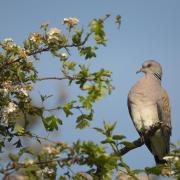A man of two careers, this Sundridge-based eye specialist and sculptor creates quasi-abstract animals and birds
Michael Glasspool works in a studio which was formerly two stables knocked into a 20ft by 12ft working area, three quarters of which is a work space with a display area including gallery spotlights. He has been based here in Sundridge for more than 40 years.
Michael enjoyed a successful career as a consultant eye specialist at Moorfields Eye Hospital, but when a back problem led to him taking early retirement, he was able to devote his time to something he had always done, but not professionally: sculpture.
Mainly self taught, he had also worked with sculptors over four or five years to learn about moulding. “I used to paint a lot, but sculpture takes so much longer; a piece can take weeks if not months,” he says.
Michael still carries on painting, but now uses acrylic and watercolour rather than oils and does mainly landscape and some still life.
When I ask what sort of challenges creating an abstract sculpture pose, he tells me: “I tend to make a detailed modelling and then pare it right back until it becomes the essence of the piece.
“The abstract pieces or even the figures begin with line and form. For example, I’m working on an acrobat which comes from the idea of Matisse’s cutouts.”
So does Michael know what his work will look like from the outset? “No, the secret of success is to let the medium guide you. Clay is easier and softer to work than wax and when I work with plaster, I have more of an idea of the finished piece because I work in layers and pare it back.
“I’m known for tactile pieces and I like to tell people to touch my sculptures.”
We discuss the current exhibition of Barbara Hepworth at Tate Britain, as she was also a sculptor who believed in touch. The downside, as Michael points out, is that a plaster piece can get grubby and in bronze the patination can wear away.
There is some colour in Michael’s work and he admits: “For about 10 years I only worked in black and white, then I got bored and started experimenting with colour, powders to produce bronze finish or even iron filings to get a rust one.
“The choice of colour depends on the subject; some look good with a verdigris finish, such as my birds, which tend towards the abstract.
“Some things are suited to bluey green, some suited to rusty colours. For figurative pieces like otters, I’d tend to work in a browny black bronze finish and finished in verdigris.”
Michael is working increasingly with bronze resin or bronze, but because of the expense he may use jesmonite, a water-based resin like plaster of Paris, that dries off as hard as stone and when finished looks like marble.
Mainly because of the line, Michael may work on the human figure, but if it is the movement which interests him, he will set a pose.
Recently he has been doing more drawing, as he has found success with some of his framed designs. However, the process of creating a sculpture may not necessarily entail a previous drawing, as Michal may go straight into clay or wax and produce the maquette.
“Art is immensely important to me. From my own point of view I couldn’t live without paintings on the walls and the house is full of 3D work by other sculptors. If you are not exposed to art, you are missing out on something.” w
Get in touch:
Visitors are welcome by appointment at the studio, Dibgate Farm, Chevening Road, Sundridge TN14 6AB, 01959 533265 or email glasspool@tiscali.co.uk
Michael’s work will be on show at The Kent Painters Group annual exhibition at Sevenoaks School on 30, 31 October and 1 November. Contact secretary@kentpaintersgroup.co.uk for more details.



























